Fertilizing Flax (SF717, Revised Sept. 2017)
Availability: Web only
Nitrogen
In contrast to the aggressive fertilizer nitrogen strategy used in wheat production, a more conservative approach is used with flax. Although yield increases are possible when nitrogen is applied to flax, other factors are often more important than the nitrogen rate.
Excessive nitrogen rates actually may reduce yield potential by stimulating more vegetative growth, causing greater susceptibility to disease and lodging. Yield and N rate are not related across locations, so the N rate of 80 pounds (lb) N/acre is valid for high-yielding fields and fields with lower productivity.
Growers shouldn’t apply more than 80 lb N/acre for flax due to disease and lodging issues. In addition, the N rate should be reduced by another 30 lb N/acre if the field has been in continuous no-till production for six years or more.
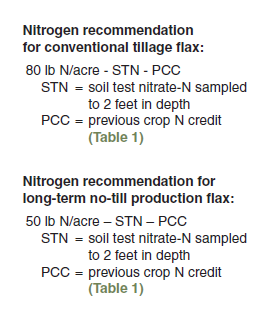

Second-year N Credits
Half of the N credit indicated for the first year for sweet clover and alfalfa is recommended, but no N credit is recommended after the second year for other crops.
In our soils, the use of this conservative formula will not result in underfertilization of flax with nitrogen. In years where higher yields are possible, mineralization of organic matter N easily will supply the extra needs of the flax crop. In years with more normal or depressed yields due to the environment, the N rate will be high enough to nourish the crop but not high enough to
promote disease or lodging.
The use of an 80 lb/acre base N rate is supported by previous work in Canada, South Dakota and North Dakota. In the North Dakota studies, seed oil content was reduced at rates greater than 60 lb N/acre, and the oil quality was reduced with increasing N rates.
Nitrogen may be applied as anhydrous ammonia preplant. However, applying the anhydrous at a slight angle to the intended direction of planting is advisable so that if seedling damage does occur, no large gaps will develop within a row (Figure 1).
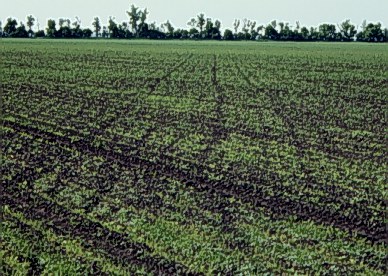
Figure 1. Spring wheat seedling damage from a fall anhydrous ammonia application in high-carbonate soils.
(NDSU photo)
Urea or liquid sources of nitrogen may be applied preplant and incorporated into the soil prior to seeding. Manure rates should be modest because predicting the actual nitrogen availability from the manure is difficult.
Phosphate
Flax is not very responsive to phosphate (P) fertilizer. Mycorrhizae are soil fungi that live in a symbiotic relationship with most plants (except for those in the mustard and lambsquarter families). The mycorrhizae receive carbohydrates from the plants, and in return, the plant receives mineral nutrients from the mycorrhizae, particularly phosphate.
Mycorrhizae hyphae (small rootlike structures, Figure 2) explore the soil within a couple of feet of the host plant and are very good at mobilizing P from the soil and transferring it to the host. Research in Manitoba has shown that when flax is not fertilized with P, yield is maintained and mycorrhizae infection is high. When flax receives fertilizer P, banded or broadcast, mycorrhizae infection is reduced (Grant et al., 2004).
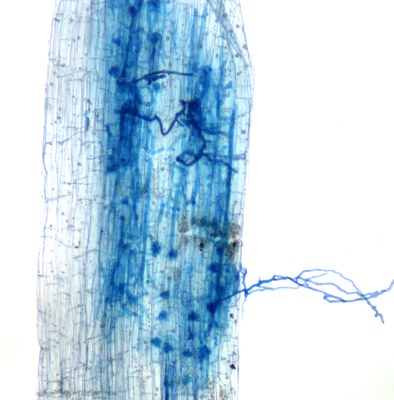
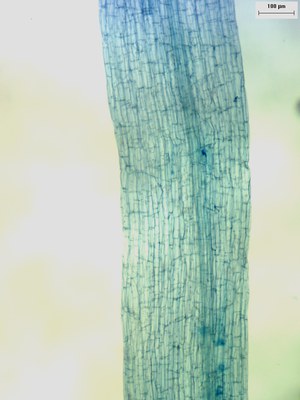
Figure 2. Mycorrhizae fungi (vesicular arbuscular mycorrhizae) infection of a flax root (left). The netting-like filaments are mycorrhizae hyphae. The dark circles are the arbusculs, where the transfer of nutrients between host and fungi occur. At the right, a flax root without mycorrhizae infection. (Photos courtesy of M.A. Monreal, Agriculture and Agri-Food, Brandon, Manitoba)
Most of the P application studies conducted on flax Canada and the U.S. show no yield increase with P fertilizer. Therefore, flax likely will not show an economic response to P application unless the soil is extremely low in available P. An exception to this may be to flax seeded following fallow or a non-mycorrhizae-supporting crop. However, producers should choose another crop in these circumstances than seed flax after fallow.
Because yield increase seldom is achieved through the application of P, no P fertilizer is recommended directly to flax. However, maintaining soil test P for wheat, corn and other crops, including flax, is important. Growers should increase the frequency of soil testing for P between crops so the appropriate amount of P is applied to nourish other more responsive crops in the rotation.
Phosphate can be applied to flax to serve as a carrier for zinc (Zn), but the grower should not expect a yield increase due to the P portion of the application. Some sources of P fertilizers also contain some cadmium. Application of some sources of unnecessary P fertilizer with flax may increase seed cadmium concentration.
Fertilizer Placement With Seed
Flax germination and young flax seedlings are sensitive to fertilizer salts and free ammonia. Growers who insist on applying fertilizer with the seed should limit the application to maximum N levels with the seed, as shown in Table 2. Application of banded P may increase susceptibility to zinc deficiency unless zinc fertilizer is added.

Zinc
If soil zinc levels (diethylenetriaminepentaacetic acid [DTPA] extract) are less than 1 part per million (ppm), application of zinc is recommended. Zinc deficiency is expressed as a condition known as “chlorotic dieback” (Figure 3).
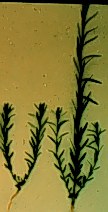
Figure 3. Zinc deficiency in flax – “chlorotic dieback.” Death of terminal bud stimulates growth of stems from axillary buds, resulting in a candelabra effect. (NDSU photo)
Zinc-deficient plants are pale and the growing point may die (Moraghan, 1978). Later in the season, the plants may sprout new shoots from lower nodes and form a candelabra appearance; maturity may be delayed.
Application of 5 to 10 lb Zn/acre as Zn-sulfate in larger granules in the seeding year may not be fully effective immediately. Application the fall before seeding may allow better Zn dispersion for more efficient crop utilization the following spring.
Fine granular Zn-sulfate is available, and 3 to 5 lb/acre Zn could be applied through granular herbicide applicators prior to seeding with more immediate results. Side-banded treatments of 1 quart/acre Zn-chelate or an ammoniated Zn liquid fertilizer also may be effective.
Rescue foliar treatments can be used, but some yield loss already may have taken place. Soil test prior to seeding, and if Zn is deficient, apply Zn at or before seeding.
Potassium
Low potassium levels are possible in some sandy soils. If low soil potassium levels are found, apply broadcast rates as indicated in Table 3. Avoid a general application of 0-0-60, potassium chloride, where possible, especially when growing food grade flax seed.
Chloride binds chemically with cadmium in the soil and increases cadmium concentration in the seed. On the other hand, application of Zn decreases cadmium absorption in flax and other crops. Other options for potassium sources include potassium sulfate, or a liquid fertilizer derived from potassium hydroxide.

Iron Chlorosis
Iron chlorosis often is confused with Zn deficiency, and sometimes they appear together. Iron chlorosis is most likely in early spring during cold, wet weather. The chlorosis appears as yellowing of upper leaves and is interveinal. The condition may be more severe in saltier areas of a field.
Foliar applications of iron are seldom effective in increasing yield, although they may green up the crop. In most years, the chlorosis will disappear quickly with warmer, drier weather.
Other Nutrients
Sulfur deficiency on flax seldom is reported, but overapplication of nitrogen or lack of adequate soil levels of sulfur may result in deficiency. Sulfur deficiency is becoming more common on most crops grown in North Dakota, but the primary deficiencies occur in small grains and corn and not on broadleaf crops, with the exception of canola.
A reliable soil test for sulfur is not available. Application of a soluble sulfate source to suspected low S soils before planting should prevent possible nutrient stress.
References
Alberta Agriculture, Food and Rural Development. 2002. Fertilizer Application and Placement, May 2002. www1.agric.gov.ab.ca
Grant, D., M. Monreal, B. Irving, D. McLaren and R. Mohr. 2004. The role of P fertility and mycorrhizae in flax production. p. 213-218. In 2004 Great Plains Soil Fertility Conference Proceedings. A.J. Schlegel, ed. March 2-3, 2004, Denver CO. Phosphate & Potash Inst., Brookings, S.D.
Moraghan, J.T. Chlorotic dieback in flax. 1978. Agronomy Journal 70:501-505.
For detailed information on general flax cultivation, see the NDSU publication “Flax Production in North Dakota”
September 2017

